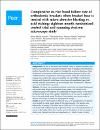Comparative in-vivo bond failure rate of orthodontic brackets when bracket base is treated with micro-abrasive blasting vs. acid etching: eighteen month randomized control trial and scanning electron microscope study
| المؤلف | Durrani, Owais Khalid |
| المؤلف | Raja, Ulfat Bashir |
| المؤلف | Chaudhary, Farooq Ahmad |
| المؤلف | Hamid, Umar |
| المؤلف | Javed, Muhammad Qasim |
| المؤلف | Atique, Sundus |
| المؤلف | Habib, Syed Rashid |
| تاريخ الإتاحة | 2024-10-28T10:44:15Z |
| تاريخ النشر | 2024 |
| اسم المنشور | PeerJ |
| المصدر | Scopus |
| الرقم المعياري الدولي للكتاب | 21678359 |
| الملخص | Background The aim of this study was threefold. Firstly, it aimed to introduce and detail a novel method for chemically etching the bases of stainless-steel orthodontic brackets. Secondly, the study sought to investigate the structural alterations within the brackets’ microstructure following chemical etching compared to those with sandblasted bases, using electron microscopy analysis. Lastly, the study aimed to evaluate and compare the long-term durability and survivability of orthodontic brackets with chemically etched bases versus those with sandblasted bases, both bonded using the conventional acid etch technique with Transbond XT adhesive, over an 18-month follow-up period. Methods The study was a randomized clinical control trial with triple blinding and split-mouth study design and consisted of two groups. The brackets in the sandblasted group were prepared by sandblasting the intaglio surface of the base of the bracket with 50 µm SiO2 particles. Hydrofluoric acid was used to roughen the base in the acid-etched group. The bases of the brackets were viewed under an electron microscope to analyze the topographical changes. Results A total of 5,803 brackets (3,006 acid-etch, 2,797 sandblasted) in 310 patients were bonded, in a split-mouth design by the same operator. The patients were followed for 18 months. The failure rate of 2.59% and 2.7% was noted in an acid-etched and sandblasted group, respectively. There was a close approximation of curves in the Kaplan-Meier plot, and the survival distribution of the two groups in the log-rank (Mantel-Cox) test was insignificant; x2 = 0.062 (P value = 0.804). Conclusion Acid etching if the bases of the brackets can be used as an alternative to sandblasting furthermore acid etching can be performed on the chair side. |
| راعي المشروع | The research was funded by Researchers Supporting Project number (RSPD2024R950), King Saud University, Riyadh, Saudi Arabia. The funders had no role in study design, data collection and analysis, decision to publish, or preparation of the manuscript. |
| اللغة | en |
| الناشر | PeerJ Inc. |
| الموضوع | Acid etching Bracket failure Brackets Sandblasting |
| النوع | Article |
| رقم العدد | 6 |
| رقم المجلد | 12 |
الملفات في هذه التسجيلة
هذه التسجيلة تظهر في المجموعات التالية
-
أبحاث طب الأسنان [410 items ]


